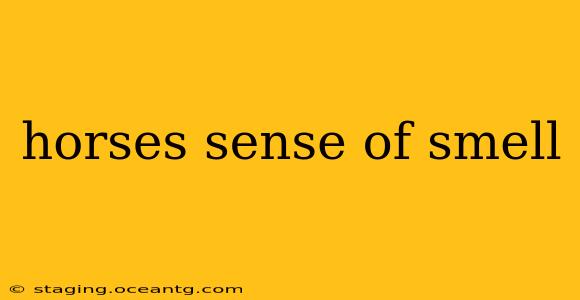Horses possess an incredibly acute sense of smell, far surpassing that of humans. This olfactory prowess plays a crucial role in their social interactions, foraging behavior, and overall survival. Understanding the intricacies of a horse's sense of smell reveals a fascinating world of communication, instinct, and environmental awareness.
How Powerful is a Horse's Sense of Smell?
A horse's olfactory system is remarkably sophisticated. Their olfactory epithelium, the tissue responsible for detecting scents, is significantly larger than that of humans, allowing them to detect a much wider range of odors at much lower concentrations. Studies suggest horses can detect scents from miles away, depending on wind conditions and the intensity of the smell. This extraordinary sensitivity allows them to identify individual horses, locate food sources, and even detect potential dangers.
What Can Horses Smell?
Horses use their sense of smell to identify a vast array of scents:
- Other Horses: They can readily distinguish individual horses based on their unique scent profiles, playing a vital role in herd dynamics and social interactions. This is particularly important for recognizing family members, establishing dominance hierarchies, and identifying potential mates.
- Predators: The scent of predators like wolves, coyotes, or even the scent of a predator’s presence (such as urine marks) can trigger a strong alarm response in horses. This innate ability is a crucial survival mechanism.
- Food Sources: Horses can locate food sources from considerable distances. They readily detect the scent of grasses, hay, fruits, and other vegetation, guiding their foraging behavior. They can even differentiate between palatable and unpalatable plants using their sense of smell.
- Environmental Changes: Subtle changes in the environment, such as the scent of rain or approaching storms, are often detectable by horses. This heightened awareness allows them to anticipate changes in weather conditions.
- Flehmen Response: The flehmen response, a characteristic lip curl often observed in horses, is a behavioral mechanism that helps them to better detect and process scents. By curling their upper lip, they draw air into the vomeronasal organ, a specialized olfactory sensory organ located in the roof of their mouth. This assists in the detection of pheromones and other subtle scents.
How Does a Horse's Nose Work?
The intricate anatomy of a horse's nose facilitates its superior sense of smell. The large surface area of the nasal passages and the highly developed olfactory epithelium provide ample space for odor molecules to interact with sensory receptors. The turbinates, bony structures within the nasal cavity, increase the surface area for better scent detection. The air inhaled through the nostrils passes over these structures, allowing for efficient processing of olfactory information.
What are the Flehmen Response and Vomeronasal Organ?
H2: What is the Flehmen Response?
The flehmen response is a distinctive behavior observed in many mammals, including horses. It involves curling the upper lip, exposing the incisor teeth, and inhaling deeply through the nostrils. This action facilitates the transfer of scent molecules to the vomeronasal organ.
H2: What is the Vomeronasal Organ?
The vomeronasal organ (VNO), also known as Jacobson's organ, is a specialized sensory organ located in the roof of the mouth, directly connected to the nasal passages. It plays a crucial role in detecting pheromones and other non-volatile chemical compounds, providing important information about the reproductive status and social standing of other horses.
Why is a Horse's Sense of Smell Important?
The extraordinary sense of smell in horses is essential for their survival and well-being. It plays a vital role in various aspects of their lives, including:
- Social Interaction: Identifying individual horses and understanding their social status within the herd.
- Foraging: Locating and selecting food sources.
- Predator Avoidance: Detecting the presence of predators and initiating appropriate escape responses.
- Reproductive Behavior: Identifying potential mates and detecting changes in reproductive status.
- Environmental Awareness: Anticipating changes in weather conditions and other environmental factors.
Understanding the complexity and significance of a horse's sense of smell enhances our appreciation for these magnificent animals and their intricate relationship with their environment. Their remarkable olfactory abilities are a testament to the evolutionary adaptations that have ensured their survival and success.
